|
Pocket PC and Trip Report Generation |
|---|
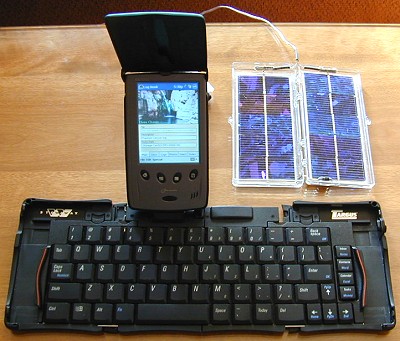
HP Jornada 548, TARGUS keyboard, PLASTECS solar charger ( Click for larger image ) |
You know you are a true geek when you carry a computer with you in the backcountry just to work on trip reports. OK, so the Pocket PC does a little bit more than that: it also let me listen to music; look at photos; read electronic books; check the times of surise & sunset and the phase of the moon; and look at star charts. Still, I know I am a true geek.
I purchased my Hewlett-Packard Jornada 548 Pocket PC back in December of 2000 and have been delighted with it ever since. It never ceases to amaze me by all of the wonderful things I can do with it and it was a real pleasure to have along on a backcountry trip. Nights in the Grand Canyon are long and, for a geek, having one of these things along, definitely does a great job to help alleviate the boredom. The basic Jornada 548 has 16Mb of ROM and 32Mb of RAM. It also has a compact flash slot (type I) so you can add additional memory (up to 512Mb) on the fly. I currently use a 64Mb card in mine. One of the main reasons that I purchased a Jornada over other Pocket PCs is because the compact flash card that it uses is the same type that is used by my Nikon CoolPix 950 digital camera. It's great to be able to pull the card out of the camera and pop it into the Pocket PC and look at the pictures you just shot.
In preparation for the backpacking trip I purchased a folding keyboard, solar charger and carrying case to hold everything. The whole setup only weighs about one pound and fits in a space of 7'' x 4'' x 2''. The full-size, folding keyboard is a must if you have a lot of notes to enter, as it just takes too long to do using the pop-up keyoard display or the character recognizer. The solar charger is also a must if you plan to use the PC at all and will be away from a power source for more than 2 or 3 days. I have not quite got the knack of using this thing yet but I did manage to keep enough of a charge in the PC to use it everyday. The battery is supposed to last 8 hours but listening to digital music and using the keyboard puts an additional drain on the battery and 6 hours is probably a better estimate.
Being a software developer helps me a lot as far as these toys go and I managed to put together a nifty set of applications to help me do my backcountry trip reports. For the Pocket PC side I downloaded and installed Microsoft's eMVB (eMbedded Visual Basic) development environment and on the Desktop side I used the full-blown version of Visual Basic. I have been developing software using Visual Basic for about 10 years now, and Microsoft is currently giving away eMVB and eMC for free so it was the perfect opportunity and combination.
The Pocket PC application (LogBook) allows me to collect information for individual dates of the trip as well as individual log entries (ordered by time) within a given date. It also has a separate section that allows me to enter information about photos I have taken (also ordered by time). If a compact flash card is removed from the digital camera and placed in the Pocket PC, I can also browse the photos within the LogBook application and add them directly to the photo database that way. There is also an indexing feature that allows me to generate a list of days, log entries and photo entries, all sorted by date and time, which can be used to jump to individual entries in any of the three databases tables that are maintained. This select list can also be filtered to show log entries, photos that will be used in trip report, photos that will be excluded from trip reports, or any combination of these. The application also has the abililty to import and export data between the database and text files which is helpful when working on multiple reports. It an awesome little application.
The desktop application allows me to take files exported from the LogBook Pocket PC database, along with photos downloaded from the digital camera, and generate trip reports from them. The results from this process are the trip reports from my April 2001 Royal Arch trip and my May 2001 Phantom & Haunted Canyons trip.The only real work involved is in manually renaming the image files into the format that is needed for the desktop application but I am sure I will eventually find a way to automate this as well. The daily index and photo index map pages are not generated by this application and those still need to be done by hand. The logs for individual days, the layout of the photos and the photo pages themselves are now entirely automated.
The Pocket PC maintains the data for the trip report using Pocket Access databases. The contents of these database can also be uploaded to the desktop computer (using Microsoft ActiveSync software that comes with the Pocket PC) and used with the full-blown version of Microsoft Access.
Sample screen shots fromPocketPC LogBook application |
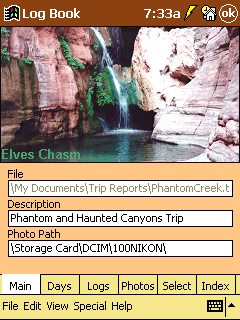
Main screen: Trip name, import/export path and photo path. Image displayed at the top is one of ten that are recycled. Clicking on the image forces it to change. |
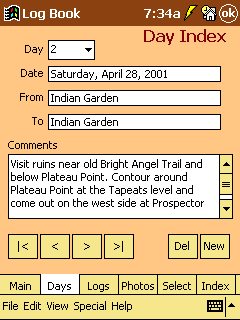
Days screen : captures and displays trp day number, date, starting and ending locations and a brief summary for that day. |
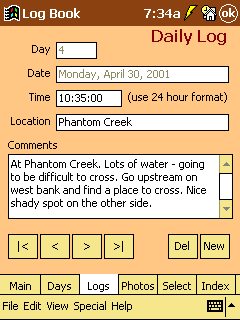
Logs screen : captures time, location and comments for multiple log entries within a given trip day. |
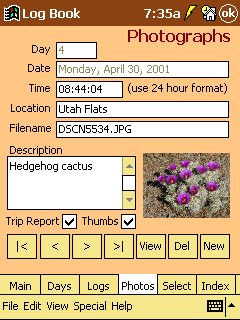
Photos screen : captures time, location, file name and description for photos taken within a given trip day. "Trip Report" check box is used to flag whether photo should be included in final trip report. "Thumbs" check box indicates whether thumbnail images should be displayed on this screen. |
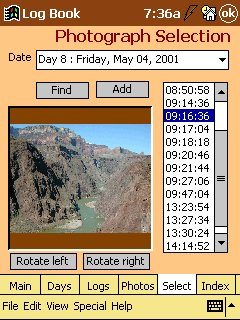
Select screen : allows images from compact flash card to be viewed and/or incorporated into the photo database and trip report. Selecting a trip date from the drop down list and pressing "Find" lists all photos taken on that date. Clicking on a time causes that image to be displayed. The "Rotate" buttons are used to rotate the image to the correct orientation. Clicking on the image itself will cause it to be displayed full-screen. The "Add" button prompts for additional information regarding the photo and adds it to the photo database. |
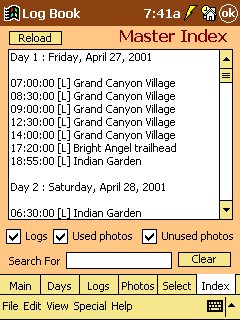
Index screen(s) : These screens allow the contents of all three trip report database tables (days, logs and photos) to be viewed in one place, sorted by date and time. Clicking on the individual entries in the list causes you to be switched to the detailed display screen for that particular item. |
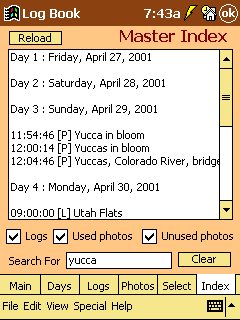
The check boxes below the list box are used to identify which entries are to be displayed in the list. Day entries are always displayed. Log entries and photo entries, for both photos to be used in trip reports as well as photos that are to be excluded, can be selected as desired.
|
|
|
|---|
|
|---|